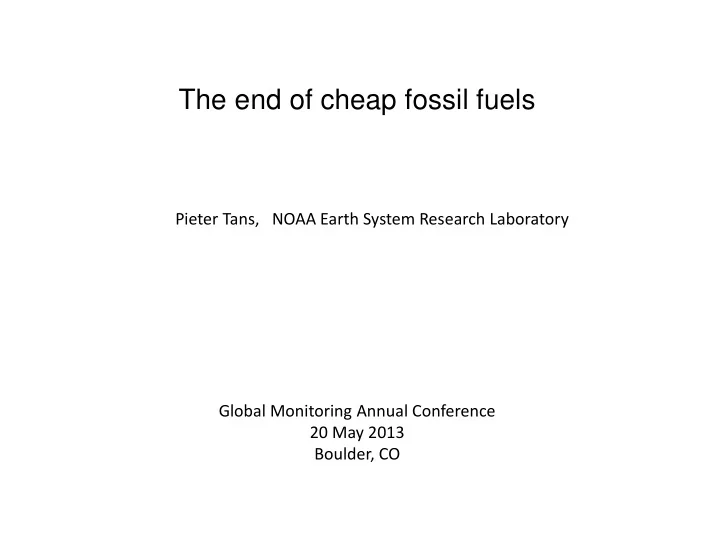

The end of cheap fossil fuels Pieter Tans, NOAA Earth System Research Laboratory Global Monitoring Annual Conference 20 May 2013 Boulder, CO
HOW MUCH ARE WE LIKELY TO BURN? British coal production history David Rutledge, Int. J. Coal Geology, 2011
HOW MUCH ARE WE LIKELY TO BURN? Rate of production = dq/dt = kq(1-q/Q) q(t) Cumulative production: q(t) Ultimate production: Q Q is estimated by fitting the logit transform of the data for different values of Q to a straight line: q(t)/Q e Q=29 Gton coal log − q(t)/Q 1 year when percent historical of total projections production stabilize consumed UK 1900 31 Australia 1995 12 China 2000 23 South Africa 1955 16 Western US 1995 20
HOW MUCH ARE WE LIKELY TO BURN? U.S. oil and gas production history U.S. oil and gas projection and reserve estimates
HOW MUCH ARE WE LIKELY TO BURN? Global oil and gas projection Published reserves plus cumulative production (BP) Projections translated to carbon emissions (billion metric ton C): cumulative reserves + long-term production cumul.prod. projection range oil & gas 193 467 495 362-495 coal 172 629 390 361-410 total 364 1069 885 743-885 Source: David Rutledge, priv. communication
HOW MUCH ARE WE LIKELY TO BURN? Haynesville play: declining production of Typical decline curve for shale gas wells wells drilled prior to 2011 in the Barnett play. 1 10 20 30 40 50 months Operating U.S. gas wells and average productivity number doubled One has to drill new wells every year just to stay even. 38% decline Source: J.D. Hughes, “Drill, baby, drill” Feb 2013, Post Carbon Institute
HOW MUCH ARE WE LIKELY TO BURN? ”Sweet spots” in Barnett pla y Dallas Fort Worth After the best spots have been found, the productivity of new wells starts declining Seven largest shale gas producing regions Source: J.D. Hughes, “Drill, baby, drill” Feb. 2013, Post Carbon Institute
HOW MUCH ARE WE LIKELY TO BURN? Tar sands projected and actual production increase EIA world oil production forecasts Actual (black line) 2000 2005 2010 2015 2020 year 2000 2010 2020 2030 year Energy return on energy invested (not including transportation, refining, distribution) old conventional oil 100:1 new conventional oil 25:1 mineable tar sands 4.5:1 in-situ tar sands 2.4:1 ethanol from corn 1.3:1 Source: J.D. Hughes, “Drill, baby, drill” Feb. 2013, Post Carbon Institute
THE CARBON CYCLE P. Tans, Oceanography 22 (4), 26-35, 2009.
THE CARBON CYCLE
THE CARBON CYCLE
FORCING OF CLIMATE CHANGE
Our predicament: To minimize the probability of catastrophic climate change emissions will have to be lowered at an aggressive pace. Net CO2 emissions have to go to zero or negative. Most emissions until now have come from the developed countries. Developing countries will likely cause most of the future emissions. We need a demonstration that development with very low emissions is an attractive option.
WE KNOW HOW TO DECREASE EMISSIONS
Several countries have demonstrated that development with much lower emissions is entirely feasible, with technology already known in the 1970s, and that it can be managed responsibly at an aggressive pace. Independent of the threat of climate change, this is our choice : We can let ourselves be forced to decrease emissions though recurring supply shortages, causing recurring economic recessions, strongly fluctuating prices, unemployment and poverty, or We adopt an energy policy to manage an orderly transition to zero carbon emissions.
Recommend
More recommend